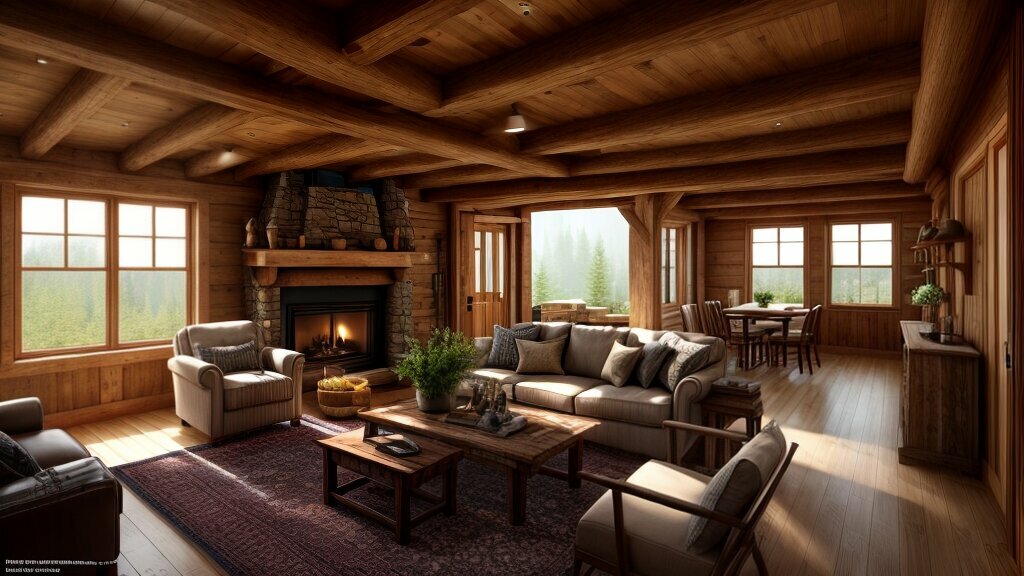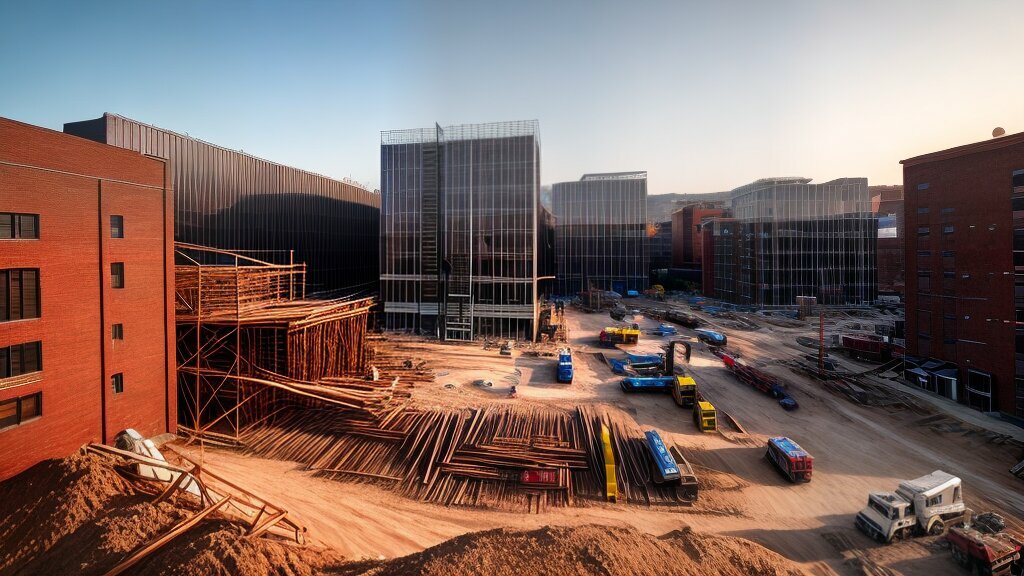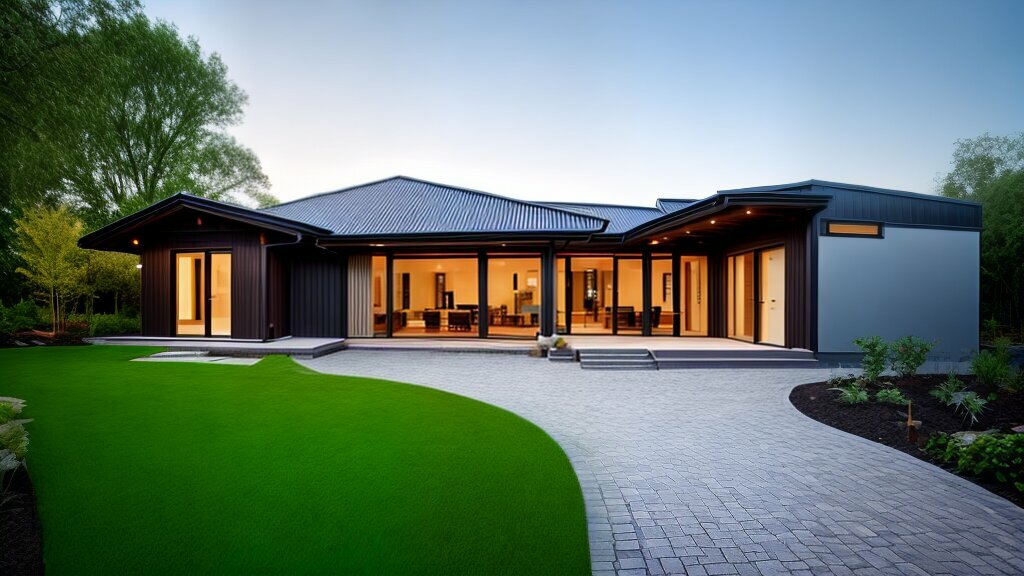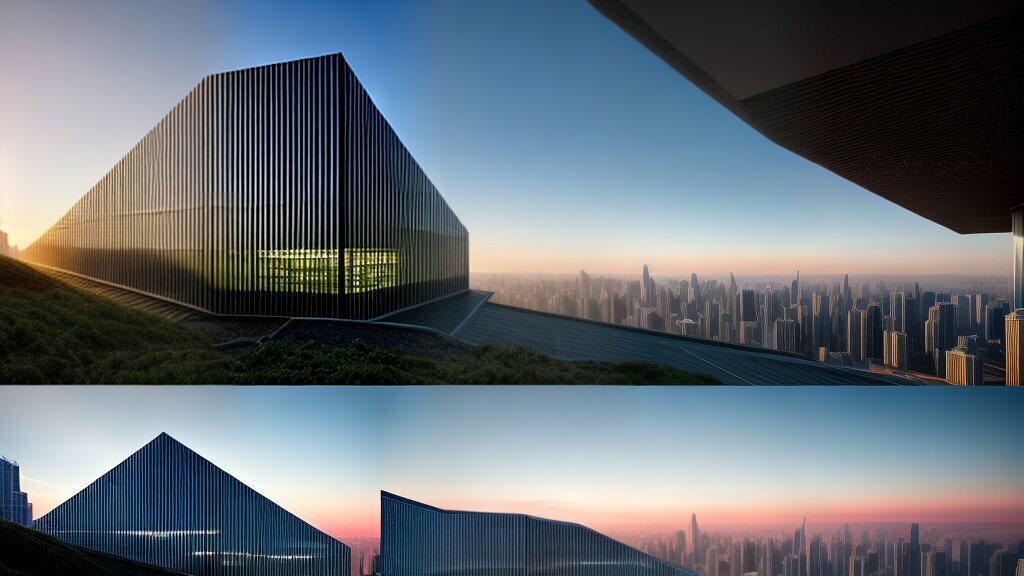Construction methods have progressed significantly over the years, from ancient building techniques to modern innovations. However, as the world becomes increasingly focused on reducing our impact on the environment, new solutions are needed to achieve sustainability without sacrificing quality or affordability. This is where hybrid construction techniques come in, combining traditional methods with modern technology to create buildings that are eco-friendly, energy-efficient, and cost-effective.
Hybrid construction techniques involve blending different styles of construction, from conventional materials like brick and mortar to newer materials like steel and composites. This approach takes advantage of the benefits of both traditional and modern methods to create buildings that are not only efficient and durable but also aesthetically pleasing and culturally significant.
Through the incorporation of energy-efficient systems and eco-friendly construction practices, hybrid construction techniques offer a promising solution for sustainable building. In this article, we will explore the history and progression of hybrid construction techniques, their advantages, and potential challenges.
Key Takeaways:
- Hybrid construction techniques combine traditional methods with modern technology to create sustainable and cost-effective buildings.
- These methods take advantage of the benefits of both traditional and modern methods to create energy-efficient and eco-friendly buildings.
- Hybrid construction techniques play a significant role in preserving cultural heritage while embracing innovation and sustainability.
The Evolution of Construction Methods
Construction methods have come a long way from the traditional brick and mortar structures of the past. With the advancement of technology and building materials, we have witnessed a revolution in the construction industry. The introduction of innovative building technologies has paved the way for hybrid buildings that blend traditional and modern methods to achieve sustainability and efficiency in construction.
Hybrid buildings are constructed through the combination of traditional and modern techniques, resulting in structures that are both innovative and sustainable. This approach not only preserves cultural heritage but also reduces the environmental impact of construction. Hybrid construction techniques involve the use of natural materials, such as timber and clay, and innovative materials like composite laminates and insulated concrete blocks.
The use of these materials has led to the creation of buildings that are energy efficient, eco-friendly, and aesthetically pleasing. As a result, hybrid construction techniques have become increasingly popular in the construction industry.
The Evolution of Construction Methods
The evolution of construction methods can be traced back to the early days of human civilization when people used natural materials such as mud, straw, and stone to construct dwellings. With the advent of industrialization, new materials such as concrete and steel were introduced, leading to the construction of skyscrapers and modern buildings.
The use of these materials has enabled the construction of towering structures that were previously impossible to build. However, as concerns over sustainability and environmental impact grew, architects and builders began to look for alternative building methods.
This led to the introduction of hybrid construction techniques which combine the durability of traditional methods with the innovation of modern technologies. Hybrid buildings are designed to be sustainable, energy-efficient, and environmentally friendly.

The use of natural materials in hybrid construction techniques has a number of advantages. Natural materials are renewable, recyclable, and biodegradable, making them a sustainable option for construction. They are also cost-effective and easy to source, reducing the overall construction cost.
On the other hand, modern technologies such as 3D printing, drones, and robotics have revolutionized the construction industry. 3D printing enables the creation of complex designs and shapes, while drones and robotics are used for surveying and site inspections. These technologies enhance efficiency, reduce construction time, and increase precision.
The combination of traditional methods with modern technologies has allowed for the creation of hybrid buildings that are both innovative and sustainable. Hybrid construction techniques have opened a new chapter in the construction industry, providing a solution to the challenges of sustainability and efficiency.
Understanding Hybrid Construction Techniques
Hybrid construction techniques combine traditional methods with modern technology to achieve sustainability, energy efficiency, and eco-friendly construction practices. By integrating the best of both worlds, hybrid buildings offer numerous advantages over purely traditional or modern construction methods.
One of the primary benefits of hybrid construction is sustainability. By incorporating eco-friendly materials and energy-efficient technologies, hybrid buildings minimize their impact on the environment. For example, buildings can be designed to use natural lighting and ventilation, reducing the need for artificial lighting and air conditioning. Additionally, by using materials such as recycled steel and low-emission concrete, hybrid buildings can be constructed with a smaller carbon footprint than traditional buildings.
Another advantage of hybrid construction techniques is cost-effectiveness. While the initial investment may be higher than traditional construction methods, the long-term savings in energy and maintenance costs can more than offset the additional expense. Hybrid buildings are also designed to be durable and resistant to wear and tear, meaning they require less maintenance and have a longer lifespan.
Finally, hybrid construction techniques offer greater flexibility in design and construction. By combining traditional and modern building technologies, architects and builders can create unique structures that preserve cultural heritage while embracing innovation. For example, a hybrid building may incorporate traditional materials such as timber alongside modern materials such as glass and steel to achieve a striking aesthetic.
Overall, hybrid construction techniques represent an exciting development in the construction industry, providing sustainable, cost-effective, and innovative building solutions for the future.

Traditional Methods in Hybrid Construction
While modern technologies play a crucial role in hybrid construction, traditional methods should not be overlooked. Incorporating traditional practices in construction not only preserves cultural heritage, but also enhances the sustainability and innovation of hybrid buildings.
One example of this is the use of adobe bricks in hybrid construction. Adobe bricks are made of a mixture of clay, sand, and straw, and have been used for centuries in many parts of the world. They are a sustainable and cost-effective building material, as they are made from locally sourced materials and do not require high energy consumption in production. When combined with modern insulation techniques, adobe bricks can provide excellent thermal performance, making them ideal for eco-friendly construction.
| Pros |
Cons |
– Sustainable and eco-friendly construction
– Cost-effective building solutions
– Low-energy production process |
– Vulnerability to water damage if not properly maintained
– Limited resistance to seismic activity
– May require additional insulation and reinforcement for optimal performance |
Another traditional method that can be incorporated in hybrid construction is timber framing. Timber framing has a long history of use in construction and is known for its sustainability, as wood is a renewable resource. Modern techniques such as engineered wood products and timber frame insulation can enhance the performance of timber framing, making it an even more viable option for sustainable building practices.

By marrying traditional and modern building techniques, hybrid construction can leverage the strengths of both methods to achieve sustainable, innovative, and cost-effective building solutions. “In conservation, there are two aspects: the technological and the social. If we only look at the technological aspect, then we are only looking at half the equation. The technological must be combined with the social”, says Frédéric Léonard, expert in building practices and sustainable architecture.
Modern Technologies in Hybrid Construction
Hybrid construction techniques involve combining traditional methods with modern technologies to create sustainable and cost-effective building solutions. As building technologies continue to evolve, new and innovative techniques are being developed to increase efficiency and reduce environmental impact.
One such example is the use of 3D printing technology in construction, which allows for the creation of complex building components in a more efficient and cost-effective manner. This technology can also reduce waste by using only the necessary amount of material, further contributing to sustainability.
Another modern technology is the use of prefabricated building components, which are manufactured off-site and assembled on-site. This approach can significantly reduce construction time and costs, as well as minimise environmental impact by reducing waste and energy consumption during construction.
To further enhance sustainability, new building materials are being developed to reduce energy consumption and carbon emissions. For example, new types of insulation materials with higher energy efficiency performance are being used to improve the thermal performance of buildings and reduce energy consumption for heating and cooling.

These modern technologies are just a few examples of how hybrid construction techniques are evolving to create more sustainable and efficient building solutions. By combining the best of traditional and modern approaches, we can create buildings that are not only environmentally friendly, but also cost-effective and innovative.
Benefits of Hybrid Construction Techniques
Hybrid construction techniques have gained popularity due to their numerous benefits. One significant advantage is that they offer a sustainable solution to building. By combining traditional methods and modern technology, hybrid construction techniques reduce the environmental impact of buildings, making them energy-efficient and eco-friendly. This sustainability factor is essential in today’s world, where there is increasing awareness of the need for eco-friendly construction practices.
Another benefit of hybrid construction techniques is cost-effectiveness. Traditional construction methods can be expensive, and modern technologies may not always be affordable. By combining the two, hybrid construction techniques offer a solution that reduces construction costs without compromising on quality or sustainability. This approach benefits both builders and clients alike, making it a win-win situation.

Hybrid construction techniques also offer flexibility in building design and construction. Builders can experiment with new materials and techniques, allowing for innovative and unique building designs. This flexibility also allows for the preservation of traditional building methods, ensuring cultural heritage is maintained while embracing innovation.
Moreover, hybrid construction techniques are not limited to a specific building type or size. They are suitable for both residential and commercial buildings, small and large-scale projects. As a result, hybrid construction techniques are widely adaptable, making them a practical and versatile choice for construction projects in a variety of contexts.
Case Studies: Successful Hybrid Construction Projects
Real-life examples of successful hybrid construction projects showcase the potential of these techniques to create sustainable and innovative buildings.
Arcology: The Sustainable City of the Future
 One of the most ambitious hybrid construction projects is Arcology, a proposed sustainable city designed by architect Paolo Soleri. The project incorporates traditional building methods with modern technologies to create eco-friendly living spaces that minimize environmental impact.
One of the most ambitious hybrid construction projects is Arcology, a proposed sustainable city designed by architect Paolo Soleri. The project incorporates traditional building methods with modern technologies to create eco-friendly living spaces that minimize environmental impact.
The city is designed to accommodate up to 5,000 people and includes various amenities such as living spaces, commercial buildings, and green spaces. It features a range of sustainable technologies such as solar power, rainwater harvesting, and composting systems to ensure efficient resource use.
“Arcology proposes a new kind of architecture that is more in tune with the environment and with human needs,” says Soleri.
The Crystal: A Zero Carbon Building
 The Crystal is a hybrid building in London that showcases the potential of sustainable construction methods. The building incorporates traditional methods such as concrete construction with modern technologies such as solar panels and rainwater harvesting systems.
The Crystal is a hybrid building in London that showcases the potential of sustainable construction methods. The building incorporates traditional methods such as concrete construction with modern technologies such as solar panels and rainwater harvesting systems.
The building is designed to be energy-efficient, with a range of sustainability features such as a green roof and intelligent lighting systems. It is a zero-carbon building, meaning that it produces as much energy as it consumes.
“The Crystal is an example of how we can use integrated design and technology to create sustainable and energy-efficient buildings,” says Jason Ball, Head of Sustainability at Siemens.
Pixel: A Net Zero Energy Building
 Pixel is a hybrid building in Australia that showcases the potential of combining traditional construction with modern design. The building incorporates traditional methods such as brickwork and timber cladding with modern technologies such as solar panels and rainwater harvesting systems.
Pixel is a hybrid building in Australia that showcases the potential of combining traditional construction with modern design. The building incorporates traditional methods such as brickwork and timber cladding with modern technologies such as solar panels and rainwater harvesting systems.
The building is designed to be energy-efficient, with a range of sustainability features such as a green wall and intelligent lighting systems. It is a net zero energy building, meaning that it produces as much energy as it consumes.
“Pixel is an example of how we can create sustainable and energy-efficient buildings that are also aesthetically pleasing,” says Andrew Burrell, the architect behind the project.
Challenges and Limitations of Hybrid Construction
While hybrid construction techniques offer numerous benefits, implementing them successfully can be challenging. One major obstacle is the lack of awareness and understanding among builders and contractors. Many are resistant to adopting new methods and materials, preferring to stick to traditional approaches they are familiar with.
Another challenge is the higher upfront costs of hybrid construction. While these costs may be offset by long-term savings in energy and maintenance, it can be difficult to convince investors and clients to invest in unproven techniques.
Additionally, sourcing materials and finding skilled labour can be challenging for hybrid construction projects, especially in regions that lack the necessary infrastructure and supply chains.
Despite these challenges, it is important to continue promoting and developing hybrid construction techniques as they offer a more sustainable and cost-effective alternative to traditional methods.

Future Trends in Hybrid Construction
The adoption of hybrid construction techniques is expected to continue growing in the future, as more builders and developers recognize the benefits of sustainable and efficient building practices.
One of the most significant future trends in hybrid construction is the advancement of construction technologies, such as 3D printing and modular construction. These innovative techniques enable faster, more accurate, and cost-effective building solutions, with reduced environmental impact. For instance, 3D printing technology can create building components with minimal waste, using recycled materials to reduce the carbon footprint of construction.
Another trend is the integration of smart technology into buildings, enhancing energy efficiency and reducing operational costs. Smart systems such as automated lighting and heating control, as well as building management software, enable precise monitoring and control of energy consumption, reducing waste and improving sustainability.
Additionally, there is likely to be increased collaboration between industries to develop new materials and methods for hybrid construction. For example, the automotive industry has already begun exploring the use of sustainable materials, such as bamboo and hemp, in vehicle production. These materials could also be utilized in building construction, providing eco-friendly and renewable alternatives to traditional building materials.

“Hybrid construction techniques are the future of sustainable building practices, combining the best of traditional methods with modern innovation to create efficient, eco-friendly building solutions.”
As the construction industry continues to evolve and adapt to changing needs and technologies, hybrid construction techniques are likely to become increasingly prevalent. By prioritizing sustainability, energy efficiency, and cost-effectiveness, builders and developers can create buildings that not only meet the needs of today but also pave the way for a more sustainable future.
The Role of Regulations and Standards
While hybrid construction techniques offer many benefits in terms of sustainability and efficiency, it’s important to ensure that these practices meet regulatory and safety standards. Regulations and standards play a crucial role in promoting the adoption of hybrid construction techniques, while also ensuring quality and safety in building practices.
Building codes, safety regulations, and environmental standards are just some of the areas where regulations and standards are in place to ensure that construction practices meet certain criteria. These regulations also help to protect builders, occupants, and the environment from potential harm.
Adhering to regulations and standards is especially important when it comes to hybrid construction techniques, as these practices may incorporate new or alternative materials and methods. Builders and contractors should be aware of the specific regulations and standards that apply to their projects and ensure that they are in compliance at all times.
As the construction industry continues to evolve and new technologies emerge, regulations and standards will play an increasingly important role in ensuring that hybrid construction practices are safe, effective, and sustainable. By remaining up-to-date on regulations and standards, builders and contractors can help to ensure that their projects are successful and contribute to a more sustainable future.

Conclusion
Hybrid construction techniques have emerged as a pioneering approach in the construction industry, embodying the marriage of traditional practices with modern innovation to create sustainable and cost-effective building solutions. Through this article, we have explored the evolution of construction methods, from traditional techniques to modern technologies and hybrid building approaches, and highlighted their importance in preserving cultural heritage while embracing innovation.
Hybrid construction techniques have significant benefits, including improved sustainability, energy efficiency, and reduced environmental impact. Furthermore, their successful implementation is evident through numerous case studies that showcase real-life examples of how these techniques have been effectively employed in various contexts.
The Future of Hybrid Construction Techniques
The future of hybrid construction techniques looks promising, with advancements in technology and techniques that may further enhance sustainability and efficiency. Today, the construction industry faces many challenges and limitations, but hybrid construction techniques offer a way of overcoming these obstacles to ensure successful implementation. It’s essential that the regulations and standards promote the adoption of hybrid construction techniques to ensure quality and safety in building practices.
In conclusion, hybrid construction techniques offer a sustainable and innovative approach to construction that addresses the challenges faced by the industry. By marrying traditional practices with modern innovation, we can create sustainable and eco-friendly buildings that preserve cultural heritage and promote innovation.
FAQ
Q: What are hybrid construction techniques?
A: Hybrid construction techniques involve the combination of traditional building methods with modern technology to create sustainable and cost-effective building solutions.
Q: How have construction methods evolved over time?
A: Construction methods have evolved from traditional techniques to the introduction of modern technologies and hybrid building approaches, incorporating innovative building materials and techniques.
Q: What are the benefits of hybrid construction techniques?
A: Hybrid construction techniques offer improved sustainability, cost-effectiveness, and reduced environmental impact, contributing to eco-friendly construction practices.
Q: How do traditional methods play a role in hybrid construction?
A: Traditional construction methods are crucial in hybrid construction as they preserve cultural heritage while embracing innovation and modern building technologies.
Q: What role do modern technologies play in hybrid construction?
A: Modern technologies play a significant role in hybrid construction, offering innovative building techniques and materials that contribute to sustainability and efficiency.
Q: Can you provide examples of successful hybrid construction projects?
A: Yes, case studies of successful hybrid construction projects demonstrate how these techniques have been implemented effectively in various contexts.
Q: What are the challenges and limitations of hybrid construction?
A: Hybrid construction techniques may face challenges and limitations, but overcoming these obstacles can ensure successful implementation and adoption of these methods.
Q: What are the future trends in hybrid construction?
A: The future of hybrid construction involves advancements in technology and techniques that further enhance sustainability and efficiency in the construction industry.
Q: What is the role of regulations and standards in hybrid construction?
A: Regulations and standards play a crucial role in promoting the adoption of hybrid construction techniques, ensuring quality and safety in building practices.
Q: What is the significance of hybrid construction techniques?
A: Hybrid construction techniques play a significant role in promoting sustainable, innovative, and eco-friendly building solutions, marrying tradition with innovation for a better future.












 One of the most ambitious hybrid construction projects is Arcology, a proposed sustainable city designed by architect Paolo Soleri. The project incorporates traditional building methods with modern technologies to create eco-friendly living spaces that minimize environmental impact.
One of the most ambitious hybrid construction projects is Arcology, a proposed sustainable city designed by architect Paolo Soleri. The project incorporates traditional building methods with modern technologies to create eco-friendly living spaces that minimize environmental impact. 













Post comments (1)